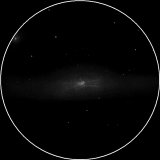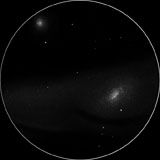
| MESSIER 31, THE ANDROMEDA GALAXY |
|---|
RA: |
00h 42m 42s |
|
DEC: |
+41° 16' 00'' |
|
Type: |
Spiral galaxy |
|
NGC: |
224 |
|
Magnitude: |
3.40 |
|
Surface brightness : |
13.50 |
|
Apparent dimensions : |
189.0'x62.0' |
|
Distance: |
2 500 000 ly |
|
The Andromeda Galaxy (also known as Messier 31, M31, or NGC 224; older texts often called it the Andromeda Nebula) is a spiral galaxy approximately 2.5 million light-years away in the constellation Andromeda. It is the nearest spiral galaxy to our own, the Milky Way. The Andromeda Galaxy is easily visible to the naked eye in a moderately dark sky, though such a sky is available only in smaller towns and isolated areas reasonably far from population centers and sources of light pollution. It appears quite small without a telescope because only the central part is bright enough to be visible, but the full angular diameter of the galaxy is seven times that of the full moon. It is generally considered to be the penultimate distant object visible to the naked eye after Triangulum. The earliest recorded observation of the Andromeda Galaxy was in 905 CE by the Persian astronomer 'Abd Al-Rahman Al Sufi,who described it as a "small cloud". Star charts of that period have it labeled as the Little Cloud. The first description of the object based on telescopic observation was given by Simon Marius in 1612. In 1785, the astronomer William Herschel noted a faint reddish hue in the core region of the galaxy. He believed it to be the nearest of all the "great nebulae" and, based on the color and magnitude of the nebula, he estimated (incorrectly) that it was no more than 2,000 times the distance of Sirius. William Huggins in 1864 observed the spectrum of Andromeda and noted that it differed from a gaseous nebula. The spectra of Andromeda displayed a continuum of frequencies, superimposed with dark lines. This was very similar to the spectra of individual stars. From this it was deduced that Andromeda had a stellar nature. The first photographs of this galaxy were taken in 1887 by Isaac Roberts from his private observatory in Sussex. The long-duration exposure allowed the spiral structure of the galaxy to be seen for the first time. However, at the time this object was commonly believed to be a nebula within our galaxy, and Roberts mistakenly believed that M31 and similar spiral nebulae were actually solar systems being formed, with the satellites birthing planets. In 1917, Heber Curtis had observed a nova within M31. Searching the photographic record, 11 more novae were discovered. Curtis noticed that these novae were, on average, 10 magnitudes fainter than those that occurred within our galaxy. As a result he was able to come up with a distance estimate of 500,000 light-years. He became a proponent of the so-called "island universes" hypothesis that held the spiral nebulae were actually independent galaxies. In 1920 the Great Debate between Harlow Shapley and Heber Curtis took place, concerning the nature of the Milky Way, spiral nebulae, and the dimensions of the universe. To support his claim that M31 was an external galaxy, Curtis also noted the appearance of dark lanes resembling the dust clouds in our own galaxies, as well as the significant Doppler shift. Edwin Hubble settled the debate in 1925 when he identified extragalactic Cepheid variable stars for the first time on astronomical photos of this galaxy. These were made using a 2.5-metre (100 in.) reflecting telescope, and they enabled the distance of M31 to be determined. His measurement demonstrated conclusively that this feature was not a cluster of stars and gas within our galaxy, but an entirely separate galaxy located a significant distance from our own. The first radio maps of the Andromeda Galaxy were made in the 1950s by John Baldwin and collaborators at the Cambridge Radio Astronomy Group. The core of the Andromeda Galaxy is called 2C 56 in the 2C radio astronomy catalogue. The Andromeda Galaxy is approaching the Sun at about 300 kilometres per second (186 miles/sec.), so it is one of the few blue shifted galaxies. Given the motion of the Solar System inside the Milky Way, one finds that the Andromeda Galaxy and the Milky Way are approaching one another at a speed of 100 to 140 kilometres per second (62–87 miles/sec.). However, this does not mean it will definitely collide with the Milky Way, since the galaxy's tangential velocity is unknown. If it is on a collision course, the impact is predicted to occur in about 3 billion years. In that case the two galaxies will likely merge to form a giant elliptical galaxy. Such events are frequent among the galaxies in galaxy groups. The measured distance to the Andromeda Galaxy was doubled in 1953 when it was discovered that there is another, dimmer type of Cepheid. In the 1990s, Hipparcos satellite measurements were used to calibrate the Cepheid distances. The corrected value gives the Andromeda Galaxy a distance of 2.9 million light-years. Unfortunately, all Cepheids lie further than Hipparcos could measure accurately, and it became clear that Hipparcos-calibrated values for Cepheids were not reliable. At least three techniques have been used to measure distances to M31. Using the Cepheid variable method, an estimate of 2.51 ± 0.13 Mly (770 ± 40 kpc) was achieved in 2004. Based upon the above distance, the diameter of M31 at the widest point is estimated to be 140 ± 4 kly. Current mass estimates for the Andromeda halo (including dark matter) give a value of approximately 1.23×10e12MSol (or 1.2 million million solar masses) compared to 1.9×10e12 MSol for the Milky Way. Thus M31 may be less massive than our own galaxy, although the error range is still too large to say for certain. M31 does contain many more stars than our own galaxy and has a much larger size. In particular, M31 appears to have significantly more common stars than the Milky Way, and the estimated luminosity of M31 is double that of our own galaxy. However the rate of star formation in the Milky Way is much higher, with M31 only producing about one solar mass per year compared to 3–5 solar masses for the Milky Way. The rate of novae in the Milky Way is also double that of M31. This suggests that M31 has experienced a great star formation phase in its past, while the Milky Way is in the middle of a current star formation phase. This could mean that in the future, the number of stars in the Milky Way will match the number observed in M31. Based on its appearance in visible light, the Andromeda galaxy is classified as an SA(s)b galaxy in the de Vaucouleurs-Sandage extended classification system of spiral galaxies. However, data from the 2MASS survey showed that the bulge of M31 has a box-like appearance, which implies that the galaxy is actually a barred galaxy with the bar viewed nearly directly along its long axis. The galaxy is inclined an estimated 77° relative to the Earth (where an angle of 90° would be viewed directly from the side.) Analysis of the cross-sectional shape of the galaxy appears to demonstrate a pronounced, S-shaped warp, rather than just a flat disk. A possible cause of such a warp could be gravitational interaction with the satellite galaxies near M31. Like the Milky Way, Andromeda Galaxy has satellite galaxies, consisting of 14 known dwarf galaxies. The best known and most readily observed satellite galaxies are M32 and M110. |
||
Other sketches |
|||||
 |
|||||
Messier 31 (Sep 06). |
|||||
VEDRAN VRHOVAC© 2006.-2007. |
